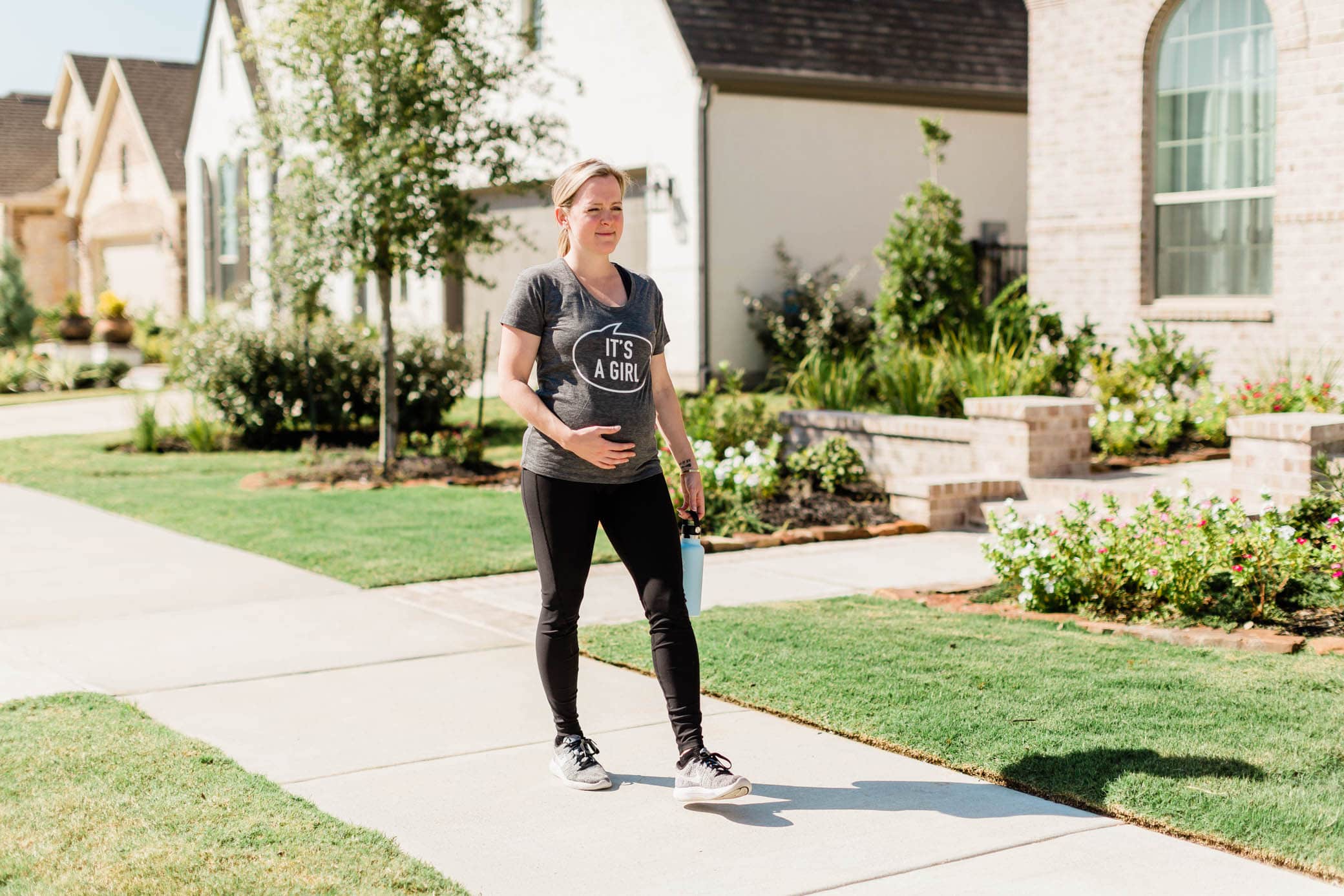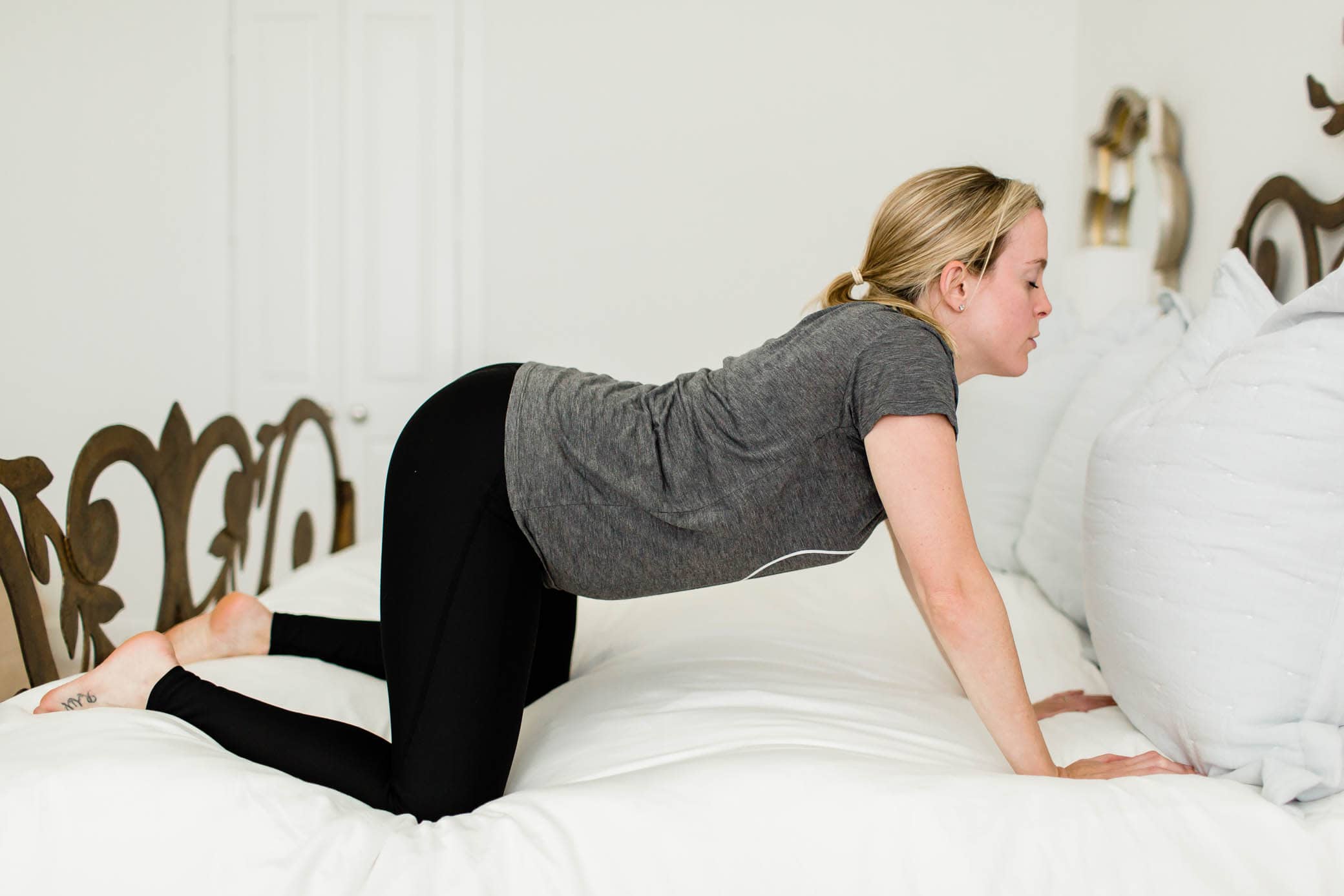I will never forget waking up in the middle of the night, 41 weeks pregnant, to the feeling of contractions. I knew something was different with these surges because I had been experiencing Braxton Hicks since I was 20 weeks pregnant. These were different, stronger, and had a pattern. Finally! I knew that this could be early labor, and I was ready to start the wild ride of childbirth.
There are three phases in the first stage of childbirth: early labor, active labor, and transition labor. And certain positions are recommended for laboring women during each phase. Many expecting moms get excited when they start feeling those first real contractions. They get up and move around to get the party started. Doing this isn’t a bad thing; however, this may exert more of their energy than recommended for early labor. If you’re wondering what to do at the beginning of labor and which early labor positions are best, here’s what you need to know.
What to Do in Early Labor
During early labor, the first phase of labor, your cervix begins to efface (thin) and dilate (open up) to about three centimeters. Laboring women should stay at home during this first phase because you want to make sure things are progressing and that you’re not experiencing prodromal labor. Prodromal labor starts and stops but doesn’t progress to fully active labor. Many people call this “false labor.” However, we feel there is nothing false about those contractions. But we would hate for a woman to experience these initial prodromal contractions and go to the hospital too soon if labor were to stop shortly after. The expecting woman would then be sent back home.
So what are the best positions and things to do to help in early labor? It depends:
- Is it daytime or nighttime?
- Did your water break, or are you only experiencing contractions?
- Are you GBS positive or negative?
- If your water has broken, are you feeling contractions at all?
It may seem odd, but all of these things can make a difference in what you should do during early labor.
Is it daytime or nighttime?
Whether it’s daytime or nighttime, remember this is just the beginning. Early labor is the longest phase of all the phases of childbirth. It is also the one that is the most manageable on your own. Early labor is the time to distract yourself, conserve energy, and get lots of rest. This is not the time to exert a ton of energy. If you do too much, you will leave yourself exhausted for active labor, transition, and pushing your baby out. These other phases and stages require much more of your focus and energy to make it to the finish line. (Remind yourself that this is a marathon, not a sprint.)
Daytime
If it’s daytime and you begin to feel contractions coming, distract yourself. Keep your mind off the contractions because you have a long way to go. Some things that you can do are:
- go on a walk
- bake cookies (you can give them to your nurses at the hospital, and they will be so thankful for the treat!)
- watch a movie
- go to a restaurant
- read a book
- meditate
- garden
Do anything that you enjoy that will keep your mind off the contractions until you cannot ignore them any longer.
Evening
If it’s the end of the day (evening time), distract yourself with the following:
- a hot shower
- a delicious dinner
- snuggling up on the couch to watch a movie
- make sure your hospital bag or birth center bag is ready
Again, ignore the contractions and don’t pay attention to the clock. Only begin paying attention to them when your contractions require you to stop what you’re doing to focus on your breathing. You won’t be able to ignore them any longer and should begin timing the length and frequency of each contraction with a contraction timer.
Night Time
It is most common for women to go into labor in the middle of the night. Why is this? Melatonin, the sleep hormone, begins to increase as sunlight decreases, and it continues building up when our bodies are ready to go to bed.1 But in full-term or late-term pregnancies, this hormone works with oxytocin, which is the hormone that creates contractions, to work more efficiently and increases its intensity, thus causing women to go into labor. In 2015, the Centers for Disease Control and Prevention (CDC) showed that most births happen in the morning or midday hours.2 This means that the majority of women begin labor at night time.
If you are in bed or are already sleeping and contractions wake you up, try to go back to sleep. Stay in your side-lying position and focus on your breath and going to sleep. Even if you’re unable to fall back asleep, rest. Don’t get up until you feel like you can’t lie down anymore. Getting as much sleep and rest as possible will give you the energy you need for the rest of your laboring journey.
Did your water break, or are you only experiencing contractions?
If you are asleep and your water breaks and you are GBS negative, get a pad and/or a towel, put them between your legs, and try to go back to sleep. Of course, check to ensure that your water is clear, does not have a foul odor (meaning there is no infection), and that your baby is still moving. If everything is normal, get some sleep. The same applies if contractions wake you up. This is the time to get as much rest as possible for a busy day of labor!
Are you Group B Strep (GBS) positive or negative?
Around week 36 of your pregnancy, you will be tested for GBS. After a few days, you should receive whether you are GBS positive or negative. No matter if it is daytime or nighttime, if your water breaks and you are GBS positive, you must receive antibiotics through an IV every four hours until your baby is born. Antibiotics protect your baby from infection. (They will give you penicillin for the antibiotics, so if you are allergic to penicillin, let your medical team know and they will provide an alternative medication.) This is why it’s encouraged that you go to the hospital soon after your water breaks if you are GBS positive. However, if you are GBS negative, you have up to 12 hours before you need to go to the hospital. So get up and get those contractions going!
If your water broke, are you feeling any contractions at all?
It is best if you have contractions when going into the hospital. If you go there without contractions and your water has broken, your medical team will need to give you Pitocin, the synthetic form of oxytocin given through an IV, to induce your labor. Pitocin can make your contractions much more intense and much faster and lead to a cascade of other interventions.3 It’s something to avoid unless medically necessary.
Best Positions for Early Labor
Now that you know what to do and what to expect, here are the positions that can help your body continue to labor no matter what time of day it is.
Daytime Positions for Early Labor
Walking
If it’s daytime and you have the energy, take a nice walk and use gravity to your advantage. You can walk around the neighborhood, the park, or even the mall if it’s cold outside. The movement of your pelvis helps move your baby further into your pelvis, and gravity helps push your baby down further onto your cervix, which will help you dilate more. Walking is a great thing to do to get this party started!

Curb walking
What is curb walking? Curb walking is when a pregnant woman walks with one foot on the road and the other foot up on the curb or sidewalk. These uneven, exaggerated steps can open your pelvis even more and place more pressure on your cervix. It’s not the most comfortable thing, but it can help your contractions strengthen.

Sitting on a birthing ball
Walking and standing can get tiring, so it’s good to sit down and rest. One of the best places to sit is on a birthing ball. Sitting on a birthing ball helps a person’s posture and helps put your baby’s head directly on your cervix. Sway side to side on the ball, make figure-eight motions, and take the pressure off your feet, but still encourage your body to continue what it needs to do to further your labor progress.

Straddle a chair
To conserve your energy, lean on the back of a chair as you sit down to rest. This position requires you to straddle the chair, which helps open your pelvis. Leaning forward can also put less pressure on your lower back. Place your pillow on the back of the chair and take a break. This is also a great position for a support person to do counter pressure and massage your back and lower back.

Nightime Positions for Early Labor
Side-lying
This is the position the majority of expecting women sleep in during pregnancy. If contractions were to wake you, continue laying on your side (preferably your left side) and try to go back to sleep. If you can’t, at least rest. Focus on your breath and relax all of the muscles in your body. Lying on your back is not recommended at this point in your pregnancy or in labor. It can reduce blood supply to your baby and cause intense lower back pain and back labor.

Child’s pose
When side-lying isn’t helping any longer, child’s pose can be a great option. This pose helps the laboring woman relieve pressure off her back, stretches her hips, and is a great position to rest in between contractions and focus on her breath.

Cat-cow pose
It can be good to stretch your back when lying down too much. Do the cat-cow yoga position to stretch your back. This position also helps your baby get into a more optimal birthing position and can decrease back labor.

Open-knee-chest
Tired but want to work with your body to continue the labor process? The open-knee-chest position is a great one. This is part of the miles circuit (see here) that I highly recommend.

Sit in the tub or stand in the shower
Step in the shower or sit in the tub to catch your breath and get more energy. Hydrotherapy is so helpful and can help you get the break you need. Don’t stay in the shower or tub for too long, though. It’s good to help relax your body and muscles, which can help increase your effacement and dilation, but it’s good to also change positions every 30 minutes to an hour.

Summary
If you don’t remember all of these details about positions to do in early labor, remember these points:
- Rest. CONSERVE YOUR ENERGY! You have a long way to go.
- Distraction, distraction, distraction – Bake cookies, watch a movie, go to a restaurant, go on a walk. Do anything that keeps your mind off these contractions until they have developed a closer pattern.
- Eat and drink plenty of fluids. – If it’s daytime, build up your energy for a wild ride with these foods to eat in early labor!






























